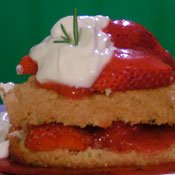Let's get a few things straight: The perennially "fresh" dessert shells stored next to the berries in the produce section aren't shortcake. Those flavorless pucks of kitchen sponge are the Twinkies of the shortcake world, and have all the nuance and nutritional value of their close relative. Shortcake does not involve shriveled fruit suspended in a gelatinous red goo. Despite what your 7-year-old nephew might believe, shortcake is not just a socially acceptable vehicle for pounds of whipped topping. You might enjoy all these things, separately or in concert, but they are pretendersmere shadows of shortcake's potential.
Shortcake is simply a lightly sweetened biscuit or scone. It's widely thought that American cookbook author Eliza Leslie published the first strawberry shortcake recipe in her 1847 cookbook "The Lady's Receipt-Book," which called for split rounds of dense pastry, fresh strawberries macerated in sugar, and an icing made of sugar and egg whites.
That said, no one out-maneuvers the British when it comes to shortcake, having had centuries to perfect Cream Tea: rich, crumbly scones smeared liberally with jam and clotted cream. My maternal grandmother spent time in England as an Air Force wife, and later passed on her love of scones and the ritual of tea to her grandchildren. Since clotted cream was difficult to find (until the advent of the international aisle), my gran would ply us with strawberry jam and whipped cream, thus beginning my shortcake obsession. Here in the South, scones evolved into mile-high biscuits with jelly or fruit butter. Your grandma's biscuit dough (lightly sweetened, rolled in sugar) would likely make an excellent shortcake, although my husband swears his grandmother would frown upon the notion.
Shortcake with fruit is not pretentious, but it does have dignity. It's equally at home on paper plates as on heirloom china, lauded by kitchen minimalists and gourmands alike. I'm currently in love with the resiny undertone of rosemary combined with the bright sweetness of strawberry, and this recipe plays on that pairing. I'm a sucker for whipped cream (homemade or extruded directly from a can into my mouth), but mascarpone blended with whipping cream closely resembles the clotted cream from my gran's fabled Cream Teas.
Macerated Strawberries
2 pints strawberries, stemmed and quartered
Juice from half a lemon
1/4 cup sugar
Toss in a bowl, and leave standing at room temperature for 30 minutes to an hour until juicy. In a separate bowl, mash or puree a cup of berries with the juices, then add back to the bulk of the berries. Refrigerate until assembly time.
Lemon-Rosemary Shortcakes
1 egg, plus 1 egg yolk
1 cup heavy cream
1 1/2 tablespoons lemon zest, finely grated
1 tablespoon fresh rosemary needles, minced, plus sprigs for garnish
2 1/2 cups all-purpose flour or whole wheat pastry flour
1/2 cup sugar, plus extra for topping the dough before baking
1 tablespoon baking powder (make sure it's fresh; old baking powder can ruin the finished product)
1/2 teaspoon salt
6 tablespoons cold unsalted butter, diced
In a small bowl, beat the egg and yolk until it lightens in color, then whisk in cold cream. Refrigerate the mixture while you assemble the rest of the ingredients. Combine all the dry ingredients in a large bowl, and then add butter. There are a few ways to integrate the butter into the mixture: You can work very quickly and rub the butter into the flour mixture, or use a pastry blender/cutter to cut in the fat. I prefer to pulse the butter and flour mix in my food processor, because I'm all about quick rewards. Whichever method you use, the resulting mixture should resemble small peas.
In a large bowl, add the cream/eggs mixture to the dry ingredients and stir to combine. Turn the dough onto a floured surface, and shape into a thick mound. If your dough seems overly loose, you can cover it and let it rest in the refrigerator for an hour.
Divide the dough into eight to 12 smaller pieces, and then roll them into smaller rounds. Work the dough quickly, or you'll wind up with highly aromatic cardboard. Sprinkle their tops with sugar before transferring to a parchment lined baking pan. Bake on the center rack at 400 degrees until fragrant and golden, about 15-18 minutes, and cool on a wire rack.
Mascarpone Cream
1 small tub Mascarpone cheese (you may use a block of cream cheese)
1/2 cup cream
Whip cream until soft peaks form. Add mascarpone, and whip until thoroughly combined.
Putting it all together
To serve, slice the cakes in half horizontally, and place the bottom on a deep plate or shallow bowl. Dole heaping spoonfuls of fruit and juice onto the cake bottoms, and follow with a dollop of mascarpone cream. Replace the top halves of the shortcakes, and top with remaining fruit and Mascarpone. Garnish with rosemary sprigs.
This recipe is fluid, and you can add your own twist to it. You can use flavored sugars, which add depth to macerated fruit; or add nuts and dried fruit to the shortcake dough. Boozy whipped cream or unadorned yogurt as a topping are also variations to consider. The beauty of fruit shortcake is its adaptability to seasonal fruit and your particular culinary voice.


